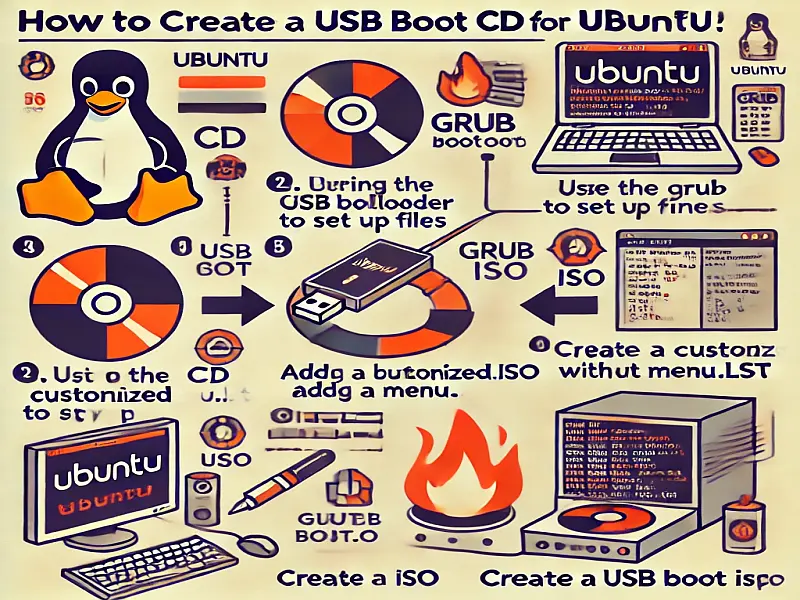To make a USB Boot CD for Ubuntu that can be used to boot your Ubuntu Live USB flash drive from a PC or Mac with a BIOS that doesn't natively support booting from USB devices, follow these steps. This process replaces our older USB Boot CD for Ubuntu tutorial, with updated requirements for later versions.

What is Ubuntu & Why do I need a USB Boot CD?
Ubuntu by Canonical Ltd, is one of the most popular Linux distributions, known for its ease of use, regular updates, and robust community support. Based on Debian, Ubuntu offers a stable and secure operating system suitable for both beginners and advanced users. Its user-friendly interface and vast repository of software make it an ideal choice for users switching from other operating systems or those looking to explore Linux.
One of the significant advantages of Ubuntu is its compatibility with a wide range of hardware, making it suitable for modern and older machines alike. However, some older computers may not support USB booting directly from the BIOS. In such cases, creating a USB Boot CD can be particularly beneficial. This method allows users to start Ubuntu booting from a CD and then hand the boot process over to the USB drive, facilitating the installation process even on systems with limited boot options.
Prerequisites to Make a USB Boot CD for Ubuntu
- PC or MacBook capable of booting from a Live CD
- USB flash drive with Ubuntu preinstalled
- CD burner and a blank CD
- Active Internet Connection
Note: This tutorial was originally written in 2008. Most modern computers support USB booting, making this process no longer necessary. If you're simply looking to create a bootable Ubuntu USB, see our guide on creating a Ubuntu bootable USB with persistence.
How to Make a USB Boot CD for Ubuntu
Tip: Use a prebuilt Live Ubuntu flash drive created with UUI and a machine that supports USB booting, so you can keep the CD burner available for the final ISO.
- Insert your Bootable Ubuntu Live USB or CD, and restart your computer, booting from the CD or USB.
- Open a Terminal and type each command below:
- Update:
sudo apt-get update - Install NVIDIA and GRUB:
sudo apt-get install --reinstall nvidia-current grub - Create Temporary Working Path:
mkdir -p ubcd/boot/grub - Add ISO/CD Boot Files:
cp /usr/lib/grub/i386-pc/stage2_eltorito ubcd/boot/grub - Edit GRUB Menu: Open the menu file:
gedit ubcd/boot/grub/menu.lstAdd the following:
title Start Ubuntu from USB DISK (MACBOOK) root (cd) kernel /boot/vmlinuz file=/cdrom/preseed/ubuntu.seed boot=casper noprompt cdrom-detect/try-usb=true persistent nouveau.noaccel=1 blacklist=vga16fb initrd /boot/initrd.lz boot title Start Ubuntu from USB DISK (PC) root (cd) kernel /boot/vmlinuz file=/cdrom/preseed/ubuntu.seed boot=casper noprompt cdrom-detect/try-usb=true persistent initrd /boot/initrd.lz boot - Copy Kernel to Temporary Directory:
cp /cdrom/casper/vmlinuz ~/ubcd/boot - Edit Modules File:
sudo gedit /etc/initramfs-tools/modulesAdd these lines:
usbcore usb-storage uhci_hcd ohci_hcd ehci_hcd sd_mod scsi_mod - Set Initramfs Wait Time:
sudo gedit /etc/initramfs-tools/initramfs.confAdd:
WAIT=8 - Rebuild Initramfs:
sudo mkinitramfs -o ubcd/boot/initrd.lz - Create the ISO:
mkisofs -R -b boot/grub/stage2_eltorito -no-emul-boot -boot-load-size 4 -boot-info-table -o usbcd.iso ubcd - Burn ISO to CD: Insert a blank CD and type:
brasero -i usbcd.iso(Or use any CD-burning software)
